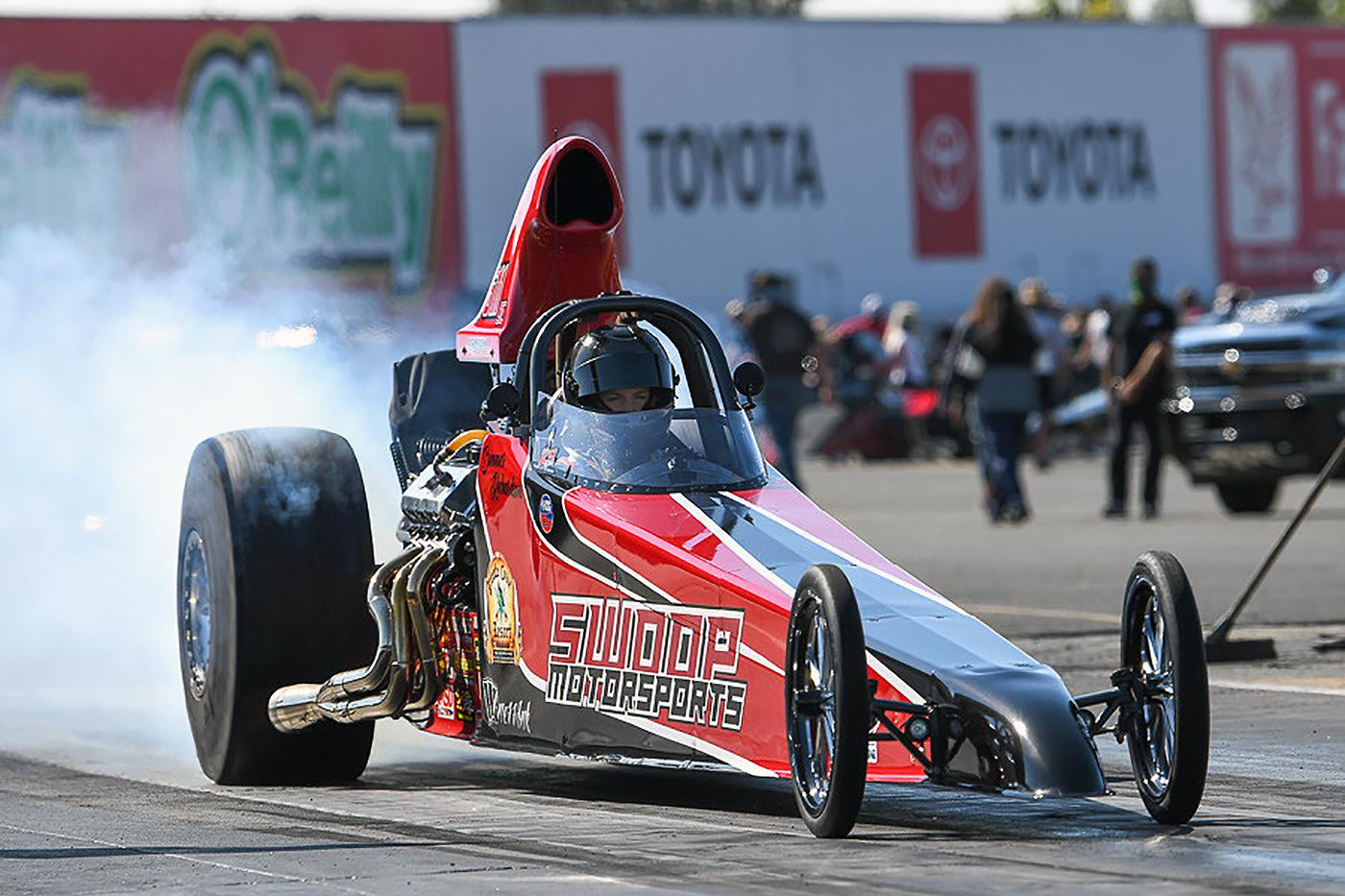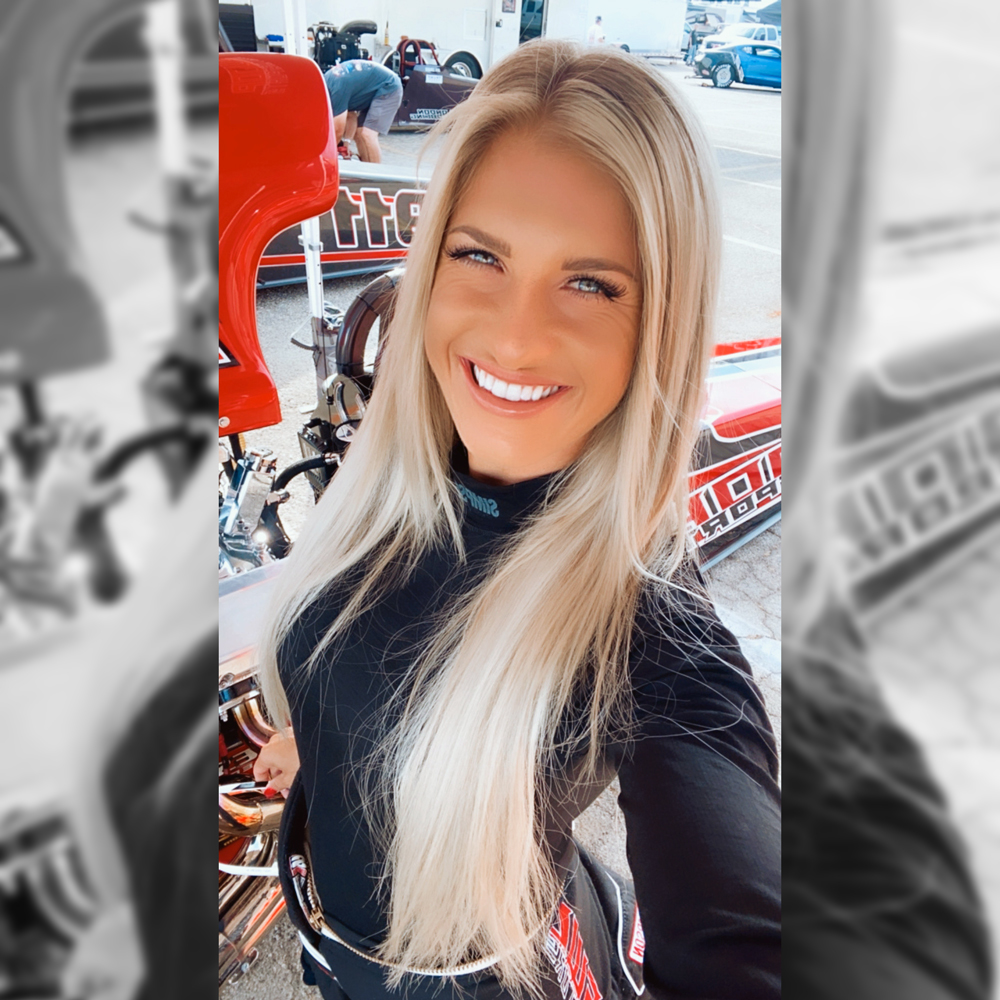Race Team Confidential: Swoop Motorsports—Summer Richardson, Santa Clarita, California

After setting speed records on water, this racer faced a whole new learning curve when she turned her attention to Super Comp and Top Dragster racing on dry land.
I started my racing career on the water with performance boats in 1-mile shootout events at Lake Havasu and Lake of the Ozarks. I have multiple records for fastest solo female powerboat driver on water, setting a world record in 2016 with a top speed of 185 mph in a 388 Skater powerboat.
After racing in shootouts for five years, the sport was becoming too dangerous, and we were seeing more boating accidents. I wanted to continue my racing career, so I turned to drag racing with my husband, Travis Richardson, and father, Don London, joining me.
It just so happened that Top Fuel driver Shawn Langdon’s dad, Chad Langdon, was selling his entire Super Comp operation. We went down to their shop, and it turned out to be a perfect fit.
Swoop Motorsports is our race team, and we have five cars in the fleet, racing in Super Comp and Top Dragster classes. My dad has been an engine builder for years, so he built all the engines for our team.
With the first dragster I raced, we modified the car just for me at London Racing Engines (my dad’s shop). We decided to go through the car from front to back to learn everything we needed to know about the driveline and give it a complete refresh. We updated the dash to Racepak, re-wired the entire car, adjusted pedal location and cables, gave it a new paint job, got a custom seat made to fit me, added a new windshield, got a new engine build from London Racing Engines, re-certified the chassis and so much more. We truly made it custom to fit me.

For the 2021 season, we recently raced at Pomona for the first time. We didn’t have any data on the cars, and track temps were hot, so let’s just say that was a learning experience for us. However, I was able to go two rounds in Top Dragster and Super Comp.
Other events we plan to attend this year are the Divisionals in Boise, Idaho, in September (at press time), then the Vegas Divisionals, followed by the Vegas Nationals and the World Finals in Pomona. This has been a very tough year, as a lot of the races got cancelled in the beginning of 2021 due to COVID-19. They were re-scheduled at the end of the year, so we had to pick and choose what we could attend.
Prepping the race cars before events usually consists of oil changes, new spark plugs, and inspections of frames, brakes, chutes, tires and electronics. Additionally, when we arrive at the track, the weather stations go up and we start monitoring the weather, especially the DA [density altitude].
In sportsman Super Comp racing, we have learned that once you get your car running great, don’t touch it. To hit your index, you have to do the same routine every time: same air psi, same dead stall, same launch rpm. We do minor changes depending on altitude, but for the most part we try not to touch them.
As for Top Dragster, we change out spark plugs every one to two runs depending if we are testing the car for heat index within the cylinders (timing mark on the plug). Then we add more fuel per gear, we check tire shake if there is any, and possibly then change launch rpm if need be.
After each run, we record all of our times and mph and input it into the Crew Chief software. We have it so dialed now that if we know what our 60-foot is, we can usually get very close to the number. The Super Comp dragsters also have Racepak to monitor all the engine data like dead stall rpm, launch rpm, engine temperature, driveshaft rpm, etc. This really helps us make sure the cars are running consistently each time. The last few years we have been collecting data at the tracks, and now it’s starting to pay off as we know what to dial coming into our first round of qualifying. It really helps us get on the number faster, then we must rely on ourselves to cut a light.
Top Dragsters are equipped with ComSync electronic fuel injection/ignition systems. This is where we collect the performance data to make any changes for the next run. We also collect data from the AFR readings, EGTs and inlet air temperature to make adjustments where they are needed.
Regarding how often we replace parts, the Super Comp dragsters are 614-cubic-inch engines that receive new valve springs, lifters, rod bolts, pistons and pushrods every two years. We adjust/check the valvetrain every two races and do frame inspection and change the spark plugs and oil every three races.
The Top Dragster engines require a little more attention as they are making upwards of 2,200 horsepower on methanol. General maintenance includes checking transmission fluid for quality, inspecting the entire frame on rail for any cracking, checking the CV joints in the driveline, performing a leakdown and compression tests. We also check the valvetrain and keep track of the number of runs for connecting rod change-out and lifters.
To wrap it up, in 2017 I went to Frank Hawley’s Drag Racing School and got licensed in Super Gas and Super Comp. In 2019, I received my Top Dragster license from Tom Bayer’s School of Drag Racing. Next on my to-do list: Top Fuel!
 MEMBERSHIP LOGIN
MEMBERSHIP LOGIN JOIN PRI
JOIN PRI


